A Deployable Conical Log Spiral Antenna for Small Spacecraft: Mechanical Design and Test
Abstract
1. Introduction
2. Manufacturing and Design
2.1. Antenna Design
2.2. Manufacturing and Materials
2.3. Epoxy Glass Transition Temperature
2.4. Carbon Fiber Volume Fraction and Braid Angle
3. Test Methods and Results
- Material property tests using dynamic and thermal mechanical analysis (DMA, TMA) with material samples;
- Antenna mass properties and spring stiffness;
- Natural frequencies of the extended, free standing spring;
- Dimensional stability with 3D scans in cold and warm environments—a Go!SCAN 3D camera (Manufactured by CREAFORM/AMETEK, Lévis, QC, Canada) was used;
- Thermal cycling test in an ambient pressure thermal chamber;
- Deployment tests with 3D scan deformation assessment, visual inspection, and RF functional tests;
- Thermal vacuum test to assess outgassing and structural integrity;
- Vibration testing with the spring compressed at levels for a typical launch vehicle. SpaceX’s rideshare program [39] levels were used.
3.1. Material Property Test Results
3.1.1. Glass Transition Temperature
3.1.2. Coefficient of Thermal Expansion
3.2. Mass Properties and Spring Stiffness
3.3. Natural Frequencies of Extended Spring Structure
3.4. Temperature Dimensional Stability Test Results
3.5. Thermal Cycling Test Results
3.6. Antenna Deployment Test Results
3.7. Thermal Vacuum Test Results
3.8. Vibration Test Results for Compressed Spring
4. Conclusions
5. Patents
Author Contributions
Funding
Data Availability Statement
Acknowledgments
Conflicts of Interest
References
- Pelton, J.N. (Ed.) Space 2.0: Revolutionary Advances in the Space Industry; Springer International Publishing: Berlin/Heidelberg, Germany, 2019. [Google Scholar]
- Imbriale, W.A.; Gao, S. (Eds.) Space Antenna Handbook, 1st ed.; Wiley: Chichester, UK, 2012. [Google Scholar]
- Jones, H.W. The Recent Large Reduction in Space Launch Cost. In Proceedings of the International Conference on Environmental Systems (ICES), Albuquerque, NM, USA, 8–12 July 2018. NASA Technical Report: 20200001093. [Google Scholar]
- Bradbury, L.M.; Diaconu, D.; Molgat Laurin, S.; Beattie, A.M.; Ma, C.; Spydevold, I.S.; Haugli, H.C.; Zee, R.E.; Harr, J.; Udnæs, F. NorSat-2: Enabling advanced maritime communication with VDES. Acta Astronaut. 2019, 156, 44–50. [Google Scholar] [CrossRef]
- Abulgasem, S.; Tubbal, F.; Raad, R.; Theoharis, P.I.; Lu, S.; Iranmanesh, S. Antenna Designs for CubeSats: A Review. IEEE Access 2021, 9, 45289–45324. [Google Scholar] [CrossRef]
- Costantine, J.; Tawk, Y.; Christodoulou, C.G.; Banik, J.; Lane, S. CubeSat Deployable Antenna Using Bistable Composite Tape-Springs. IEEE Antennas Wirel. Propag. Lett. 2012, 11, 285–288. [Google Scholar] [CrossRef]
- Johnson, J.T.; Jezek, K.C.; Macelloni, G.; Brogioni, M.; Tsang, L.; Dinnat, E.P.; Walker, J.P.; Ye, N.; Misra, S.; Piepmeier, J.R.; et al. Microwave Radiometry at Frequencies From 500 to 1400 MHz: An Emerging Technology for Earth Observations. IEEE J. Sel. Top. Appl. Earth Obs. Remote. Sens. 2021, 14, 4894–4914. [Google Scholar] [CrossRef]
- Brogioni, M.; Leduc-Leballeur, M.; Andrews, M.J.; Macelloni, G.; Johnson, J.T.; Jezek, K.C.; Yardim, C. 500–2000-MHz Airborne Brightness Temperature Measurements Over the East Antarctic Plateau. IEEE Geosci. Remote. Sens. Lett. 2022, 19, 7001005. [Google Scholar] [CrossRef]
- Jezek, K.C.; Johnson, J.T.; Tan, S.; Tsang, L.; Andrews, M.J.; Brogioni, M.; Macelloni, G.; Durand, M.; Chen, C.C.; Belgiovane, D.J.; et al. 500–2000-MHz Brightness Temperature Spectra of the Northwestern Greenland Ice Sheet. IEEE Trans. Geosci. Remote. Sens. 2018, 56, 1485–1496. [Google Scholar] [CrossRef]
- Andrews, M.J.; Johnson, J.T.; Brogioni, M.; Macelloni, G.; Jezek, K.C. Properties of the 500–2000-MHz RFI Environment Observed in High-Latitude Airborne Radiometer Measurements. IEEE Trans. Geosci. Remote. Sens. 2022, 60, 5301311. [Google Scholar] [CrossRef]
- The Things Network. Frequencies by Country. 2023. Available online: https://www.thethingsnetwork.org/docs/lorawan/frequencies-by-country/ (accessed on 28 March 2023).
- Naveena, M.; Singh, D.K.; Singh, H. Design of UHF band UWB antenna for foliage penetration application. In Proceedings of the 2017 IEEE International Conference on Antenna Innovations & Modern Technologies for Ground, Aircraft and Satellite Applications (iAIM), Bangalore, India, 24–26 November 2017; pp. 1–3. [Google Scholar] [CrossRef]
- Manohar, V.; Bhardwaj, S.; Venkatakrishnan, S.B.; Volakis, J.L. VHF/UHF Ultrawideband Tightly Coupled Dipole Array for CubeSats. IEEE Open J. Antennas Propag. 2021, 2, 702–708. [Google Scholar] [CrossRef]
- Islam, M.R.; Carvalho, M.; Venkatakrishnan, S.B.; Volakis, J.L. Packable and Readily Deployable Tightly Coupled Dipole Array (TCDA) with Integrated Planar Balun. IEEE Open J. Antennas Propag. 2022, 3, 1206–1217. [Google Scholar] [CrossRef]
- Abulgasem, S.; Tubbal, F.; Raad, R.; Theoharis, P.I.; Liu, S.; Ali Khan, M.U. A Wideband Metal-Only Patch Antenna for CubeSat. Electronics 2021, 10, 50. [Google Scholar] [CrossRef]
- Costantine, J.; Tawk, Y.; Moth, S.; Christodoulou, C.G.; Barbin, S.E. A modified helical shaped deployable antenna for cubesats. In Proceedings of the 2012 IEEE-APS Topical Conference on Antennas and Propagation in Wireless Communications (APWC), Cape Town, South Africa, 2–7 September 2012; pp. 1114–1116. [Google Scholar] [CrossRef]
- Costantine, J.; Tran, D.; Shiva, M.; Tawk, Y.; Christodoulou, C.G.; Barbin, S.E. A deployable quadrifilar helix antenna for CubeSat. In Proceedings of the 2012 IEEE International Symposium on Antennas and Propagation, Chicago, IL, USA, 8–14 July 2012; pp. 1–2. [Google Scholar]
- Balanis, C.A. Antenna Theory Analysis and Design, 4th ed.; John Wiley & Sons: Hoboken, NJ, USA, 2016. [Google Scholar]
- Liu, A.; Lu, J. A UHF Deployable Log Periodic Dipole Antenna: Concept, Design, and Experiment. IEEE Trans. Antennas Propag. 2021, 69, 538–543. [Google Scholar] [CrossRef]
- Olson, G.; Pellegrino, S.; Costantine, J.; Banik, J. Structural Architectures for a Deployable Wideband UHF Antenna. In Proceedings of the 53rd AIAA/ASME/ASCE/AHS/ASC Structures, Structural Dynamics and Materials Conference 20th AIAA/ASME/AHS Adaptive Structures Conference 14th AIAA, Honolulu, HI, USA, 23–26 April 2012. [Google Scholar]
- Costantine, J.; Tawk, Y.; Ernest, A.; Christodoulou, C.G. Deployable antennas for CubeSat and space communications. In Proceedings of the 2012 6th European Conference on Antennas and Propagation (EUCAP), Prague, Czech Republic, 26–30 March 2012; pp. 837–840. [Google Scholar] [CrossRef]
- Williams, L.R.; Hoel, K.V.; Bråten, L.E.; Sagsveen, B. Design and Test of a UHF Deployable Conical Log Spiral Antenna for Small Satellites. In Proceedings of the 18th European Conference on Antennas and Propagation (EuCAP), Glasgow, UK, 17–22 March 2024; pp. 1–5. [Google Scholar]
- Ernest, A.J.; Tawk, Y.; Costantine, J.; Christodoulou, C.G. A Bottom Fed Deployable Conical Log Spiral Antenna Design for CubeSat. IEEE Trans. Antennas Propag. 2015, 63, 41–47. [Google Scholar] [CrossRef]
- Ernest, A.; Tawk, Y.; Christodoulou, C.G.; Costantine, J. A deployable conical log-spiral antenna design for CubeSat applications. In Proceedings of the 2012 IEEE International Symposium on Antennas and Propagation, Chicago, IL, USA, 8–14 July 2012; pp. 1–2. [Google Scholar]
- Costantine, J.; Tawk, Y.; Maqueda, I.; Sakovsky, M.; Olson, G.; Pellegrino, S.; Christodoulou, C.G. UHF Deployable Helical Antennas for CubeSats. IEEE Trans. Antennas Propag. 2016, 64, 3752–3759. [Google Scholar] [CrossRef]
- Costantine, J.; Tawk, Y.; Christodoulou, C.G.; Maqueda, I.; Sakovsky, M.; Pellegrino, S. A new UHF deployable antenna for cubeSats. In Proceedings of the 2015 IEEE International Symposium on Antennas and Propagation & USNC/URSI National Radio Science Meeting, Vancouver, BC, Canada, 19–25 July 2015; pp. 1426–1427. [Google Scholar]
- Yang, Y.H.; Guo, J.L.; Sun, B.H.; Huang, Y.H. Dual-Band Slot Helix Antenna for Global Positioning Satellite Applications. IEEE Trans. Antennas Propag. 2016, 64, 5146–5152. [Google Scholar] [CrossRef]
- Rabemanantsoa, J.; Sharaiha, A. Size Reduced Multi-Band Printed Quadrifilar Helical Antenna. IEEE Trans. Antennas Propag. 2011, 59, 3138–3143. [Google Scholar] [CrossRef]
- Byun, G.; Choo, H.; Kim, S. Design of a Dual-Band Quadrifilar Helix Antenna Using Stepped-Width Arms. IEEE Trans. Antennas Propag. 2015, 63, 1858–1862. [Google Scholar] [CrossRef]
- Yao, Y.; Liao, S.; Wang, J.; Xue, K.; Balfour, E.A.; Luo, Y. A New Patch Antenna Designed for CubeSat: Dual feed, LS dual-band stacked, and circularly polarized. IEEE Antennas Propag. Mag. 2016, 58, 16–21. [Google Scholar] [CrossRef]
- Sun, Y.; Liao, S.; Zhang, W.; Che, W.; Xue, Q. UHF Compact Dual-Band Circularly Polarized Antenna Loaded with Split-Ring Resonators for Satellite Communications. In Proceedings of the 2020 IEEE MTT-S International Wireless Symposium (IWS), Shanghai, China, 20–23 September 2020; pp. 1–3. [Google Scholar] [CrossRef]
- Charles, R.A. Design, Construction and Testing of the Deployable UHF Antenna for Skynet 4 Stage 2. In IUTAM-IASS Symposium on Deployable Structures: Theory and Applications; Pellegrino, S., Guest, S.D., Eds.; Springer: Dordrecht, The Netherlands, 2000; pp. 77–86. [Google Scholar]
- Wang, H.j.; Fan, B.; Yi, M.; Guan, F.L.; Liu, G.; Chen, X.; Xu, Y.; Huang, J.; Cai, M.; Liu, S. Inflatable Antenna for Space-Borne Microwave Remote Sensing. IEEE Antennas Propag. Mag. 2012, 54, 58–67. [Google Scholar] [CrossRef]
- Tserpes, K.; Sioutis, I. Advances in Composite Materials for Space Applications: A Comprehensive Literature Review. Aerospace 2025, 12, 215. [Google Scholar] [CrossRef]
- Patil, A.S.; Arnold, E.J. Characterizing Carbon Fiber Conductivity for Structural Antenna Applications. IEEE Trans. Antennas Propag. 2022, 70, 451–458. [Google Scholar] [CrossRef]
- Williams, L.R.; Hoel, K.V.; Bråten, L.E.; Romeijer, A.; Hjermann, N.; Sagsveen, B. A Deployable Conical Log Spiral Antenna for Small Spacecraft: Electronic Design and Test. Aerospace 2025, 12, 218. [Google Scholar] [CrossRef]
- Pelton, J.N.; Madry, S. (Eds.) Handbook of Small Satellites: Technology, Design, Manufacture, Applications, Economics and Regulation; Springer International Publishing: Cham, Switzerland, 2020. [Google Scholar]
- ECSS. Thermal Testing for the Evaluation of Space Materials, Processes, Mechanical Parts and Assemblies; European Coorporation for Space Standardization: Noordwijk, The Netherlands, 2008. [Google Scholar]
- Rideshare Payload User’s Guide. SpaceX Rideshare Program Documentation. 2024. Available online: https://www.spacex.com/rideshare/ (accessed on 11 December 2024).
- Wertz, J.; Everett, D.; Puschell, J. Space Mission Engineering: The New SMAD; Space Technology Library, Microcosm Press: Portland, OR, USA, 2011. [Google Scholar]
- Dyson, J. The characteristics and design of the conical log-spiral antenna. IEEE Trans. Antennas Propag. 1965, 13, 488–499. [Google Scholar] [CrossRef]
- Dyson, J.D. The unidirectional equiangular spiral antenna. IRE Trans. Antennas Propag. 1959, 7, 329–334. [Google Scholar] [CrossRef]
- Dyson, J.D. A survey of the very wide band and frequency independent antennas-1945 to the present. J. Res. Natl. Bur. Stand. Sect. D Radio Propag. 1962, 66D, 1. [Google Scholar] [CrossRef]
- Dyson, J.; Mayes, P. New circular-polarized frequency-independent antennas with conical beam or omnidirectional patterns. IRE Trans. Antennas Propag. 1961, 9, 334–342. [Google Scholar] [CrossRef]
- Stephen, C.; Selvam, R.; Suranjan, S. A Comparative Study of Steel and Composite Helical Springs Using Finite Element Analysis. In Proceedings of the 2019 Advances in Science and Engineering Technology International Conferences (ASET), Dubai, United Arab Emirates, 26 March–10 April 2019; pp. 1–6. [Google Scholar]
- Wu, L.; Chen, L.; Fu, H.; Jiang, Q.; Wu, X.; Tang, Y. Carbon fiber composite multistrand helical springs with adjustable spring constant: Design and mechanism studies. J. Mater. Res. Technol. 2020, 9, 5067–5076. [Google Scholar] [CrossRef]
- Russell-Stevens, M.; Todd, R.; Papakyriacou, M. The effect of thermal cycling on the properties of a carbon fibre reinforced magnesium composite. Mater. Sci. Eng. A 2005, 397, 249–256. [Google Scholar] [CrossRef]
- Luger, M.; Traxl, R.; Hofer, U.; Hirzinger, B.; Lackner, R. RUC-based multi-scale model for braid-reinforced polymers: Application to coil springs. Compos. Part B Eng. 2018, 155, 431–443. [Google Scholar] [CrossRef]
- Singer, G.; Sinn, G.; Lichtenegger, H.C.; Veigel, S.; Zecchini, M.; Wan-Wendner, R. Evaluation of in-situ shrinkage and expansion properties of polymer composite materials for adhesive anchor systems by a novel approach based on digital image correlation. Polym. Test. 2019, 79, 106035. [Google Scholar] [CrossRef]
- Muliana, A.H. Spatial and temporal changes in physical properties of epoxy during curing and their effects on the residual stresses and properties of cured epoxy and composites. Appl. Eng. Sci. 2021, 7, 100061. [Google Scholar] [CrossRef]
- Ramos, J.; Pagani, N.; Riccardi, C.; Borrajo, J.; Goyanes, S.; Mondragon, I. Cure kinetics and shrinkage model for epoxy-amine systems. Polymer 2005, 46, 3323–3328. [Google Scholar] [CrossRef]
- Michel, M.; Ferrier, E. Effect of curing temperature conditions on glass transition temperature values of epoxy polymer used for wet lay-up applications. Constr. Build. Mater. 2020, 231, 117206. [Google Scholar] [CrossRef]
- Sun, Q.; Feng, Y.; Guo, J.; Wang, C. High performance epoxy resin with ultralow coefficient of thermal expansion cured by conformation-switchable multi-functional agent. Chem. Eng. J. 2022, 450, 138295. [Google Scholar] [CrossRef]
- Karadeniz, Z.H.; Kumlutas, D. A numerical study on the coefficients of thermal expansion of fiber reinforced composite materials. Compos. Struct. 2007, 78, 1–10. [Google Scholar] [CrossRef]
- Chen, L.; Xing, W.; Wu, L.; Chong, J.; Lei, T.; Jiang, Q.; Tang, Y. Understanding multiple parameters affecting static and dynamic performances of composite helical springs. J. Mater. Res. Technol. 2022, 20, 532–550. [Google Scholar] [CrossRef]
- Jun, K.; Zhen-yu, W.; Yi-sheng, L.; Zhong, X.; Xu-dong, H. Design method, performance investigation and manufacturing process of composite helical springs: A review. Compos. Struct. 2020, 252, 112747. [Google Scholar]
- Zimmermann, J.; Sadeghi, M.; Schroeder, K. Exposure of structural epoxy adhesive to combination of tensile stress and γ-radiation. Int. J. Adhes. Adhes. 2020, 97, 102496. [Google Scholar] [CrossRef]
- Yan, M.; Liu, L.; Chen, L.; Li, N.; Jiang, Y.; Xu, Z.; Jing, M.; Hu, Y.; Liu, L.; Zhang, X. Radiation resistance of carbon fiber-reinforced epoxy composites optimized synergistically by carbon nanotubes in interface area/matrix. Compos. Part B Eng. 2019, 172, 447–457. [Google Scholar] [CrossRef]
- He, Y.; Suliga, A.; Brinkmeyer, A.; Schenk, M.; Hamerton, I. Atomic oxygen degradation mechanisms of epoxy composites for space applications. Polym. Degrad. Stab. 2019, 166, 108–120. [Google Scholar] [CrossRef]
- Franck, A. Viscoelasticity and Dynamic Mechanical Testing; TA Instruments Literature: Melbourne, Australia, 2024. [Google Scholar]
- Falchi, A.; Gentile, L.; Minisci, E.; Tirelli, M.; Perugini, P. Launcher Vehicle Aerothermodynamics and Fairing Separation Altitude Effects on Payload Temperature. In Proceedings of the 7th European Conference for Aeronautics and Aerospace Sciences (EUCASS), Madrid, Spain, 1–4 July 2019; pp. 1–16. [Google Scholar]
- Williams, L.R.; Hoel, K.V.; Bråten, L.E.; Sagsveen, B. A mechanical and RF performance trade-off for a deployable conical log spiral antenna for spacecrafts. In Proceedings of the 19th European Conference on Antennas and Propagation (EuCAP), Stockholm, Sweden, 30 March–4 April 2025. [Google Scholar]
- Liu, K.C.; Maghami, P.; Blaurock, C. Reaction Wheel Disturbance Modeling, Jitter Analysis, and Validation Tests for Solar Dynamics Observatory. In Proceedings of the AIAA Guidance, Navigation, and Control Conference, Honolulu, HI, USA, 18–21 August 2008. NASA Document ID: 20080039248. [Google Scholar]
- Madrazo, C. Carbon Fiber Coil Spring Characterization and Manufacturing. Master’s Thesis, University of Nevada, Las Vegas, NY, USA, 2022. [Google Scholar]
- Volakis, J.L. Antenna Engineering Handbook, 5th ed.; McGraw-Hill Education: New York, NY, USA, 2019. [Google Scholar]
- NASA-HDBK-4006; Low Earth Orbit Spacecraft Charging Design Handbook. National Aeronautics and Space Administration: Washington, DC, USA, 2007.
- ASTM E595-15; Standard Test Method for Total Mass Loss and Collected Volatile Condensable Materials from Outgassing in a Vacuum Environment. ASTM International Documentation: Conshohocken, PA, USA, 2021.
- Leybold. How Is the Mean Free Path of gAs Molecules Calculated? 2024. Available online: https://www.leybold.com/en-ie/knowledge/vacuum-fundamentals/fundamental-physics-of-vacuum/outgassing-and-the-mean-free-path (accessed on 1 December 2024).

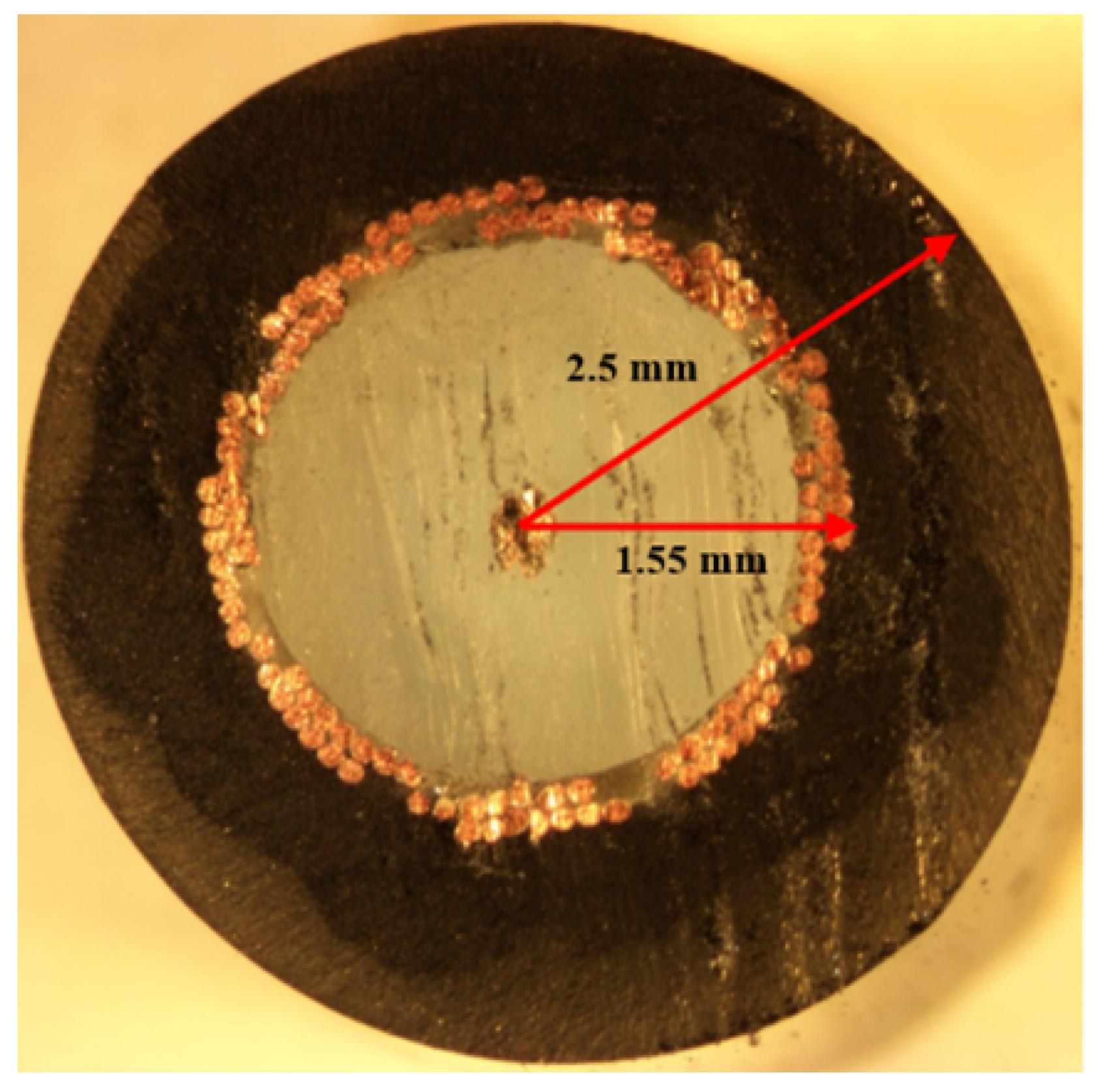





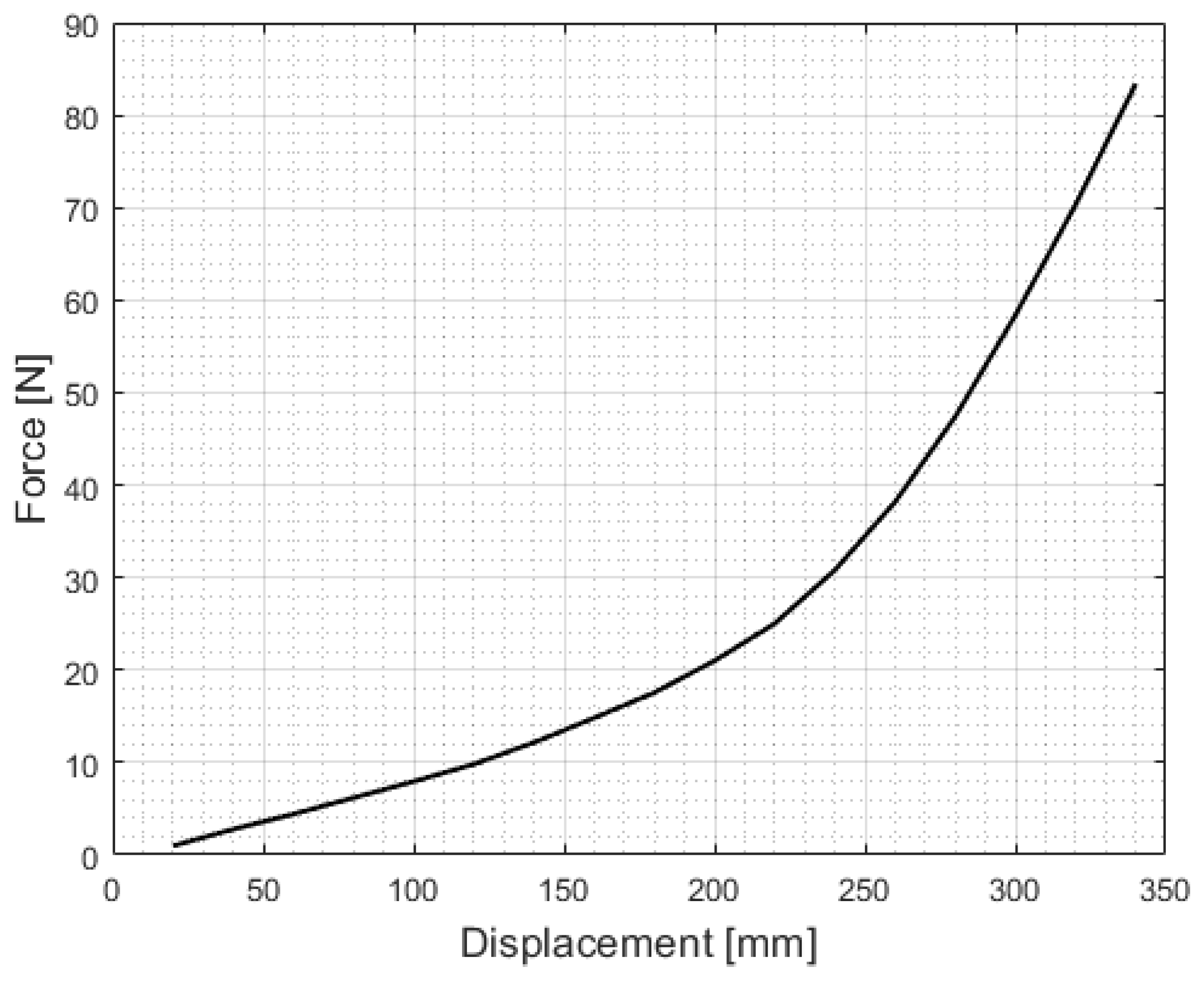
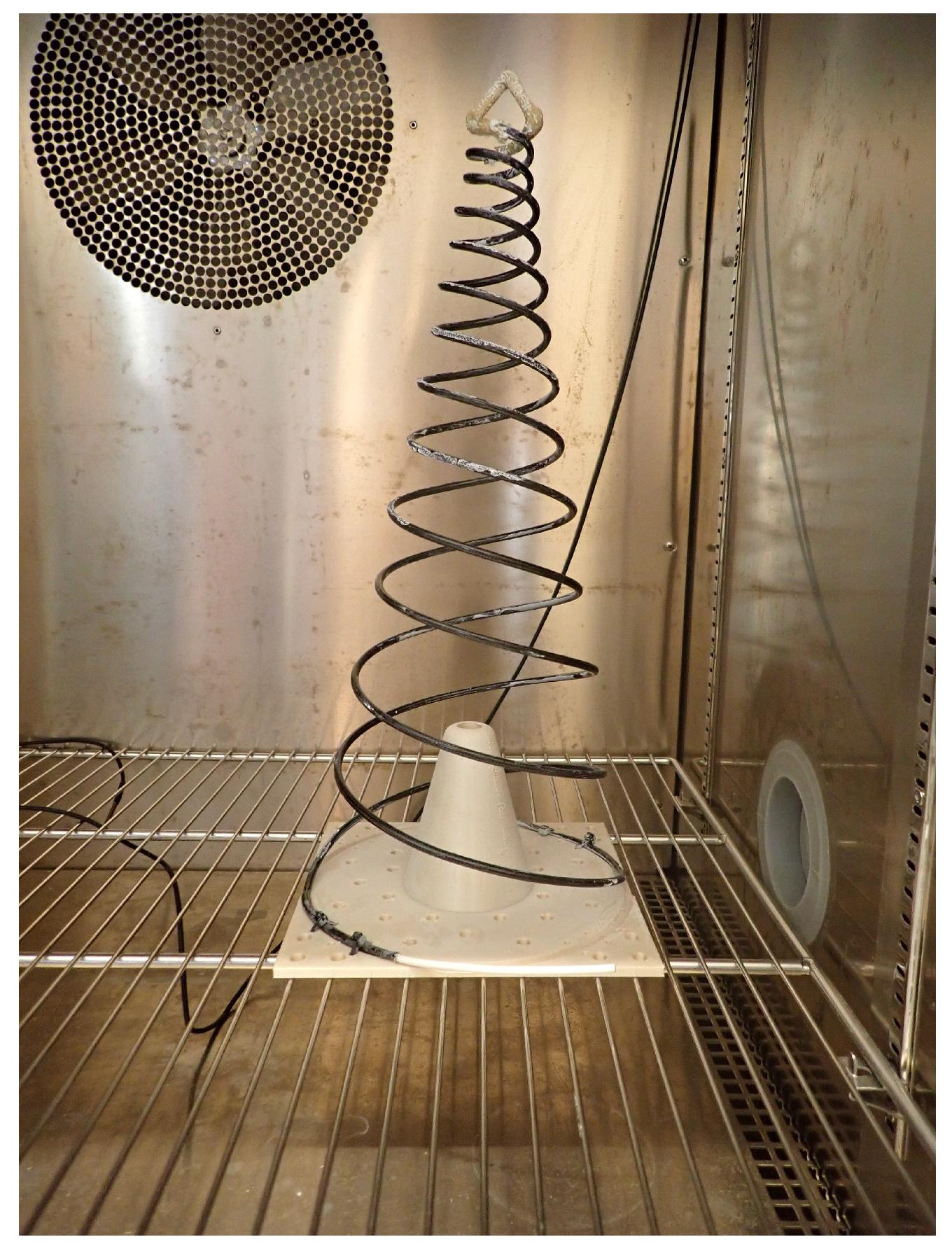

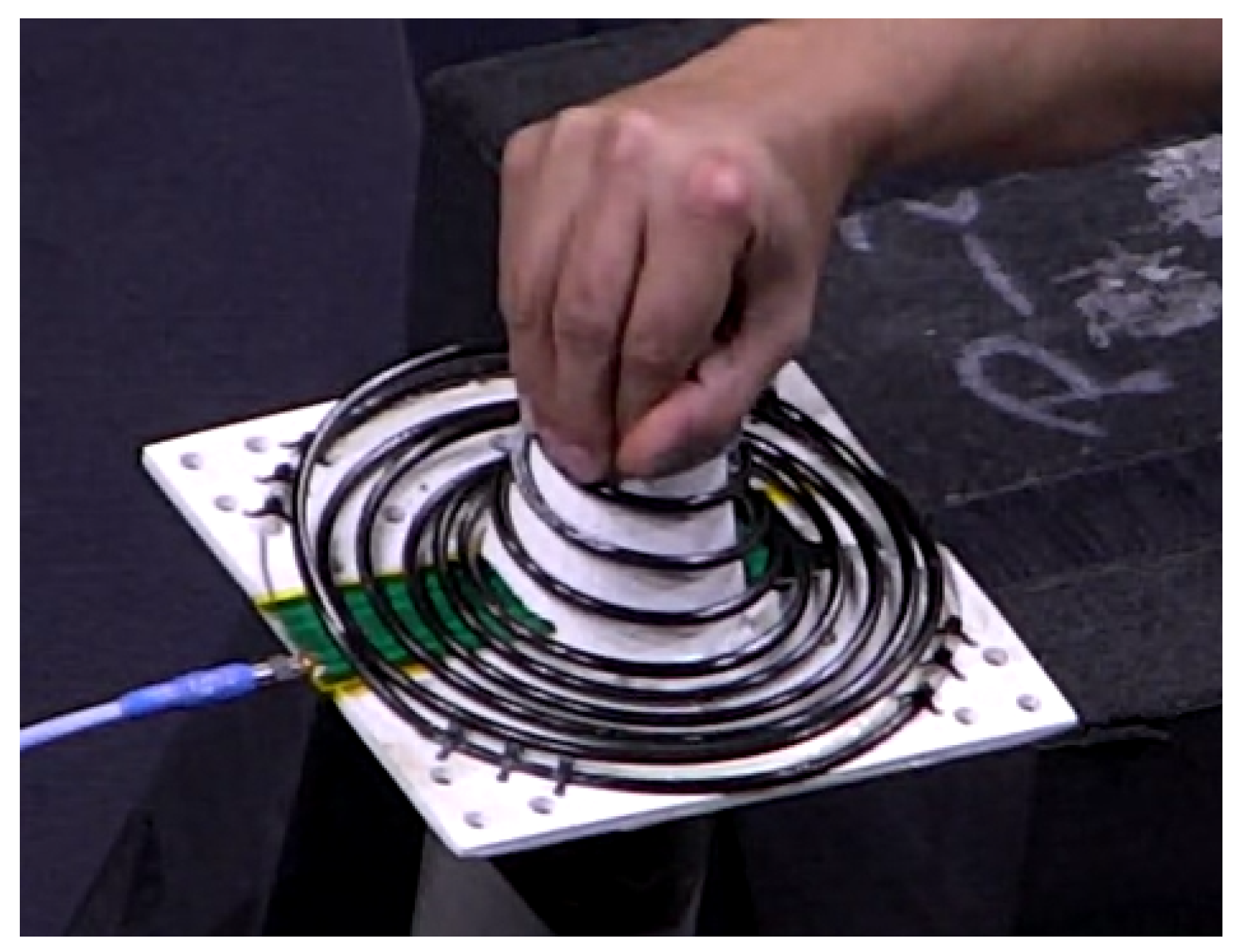
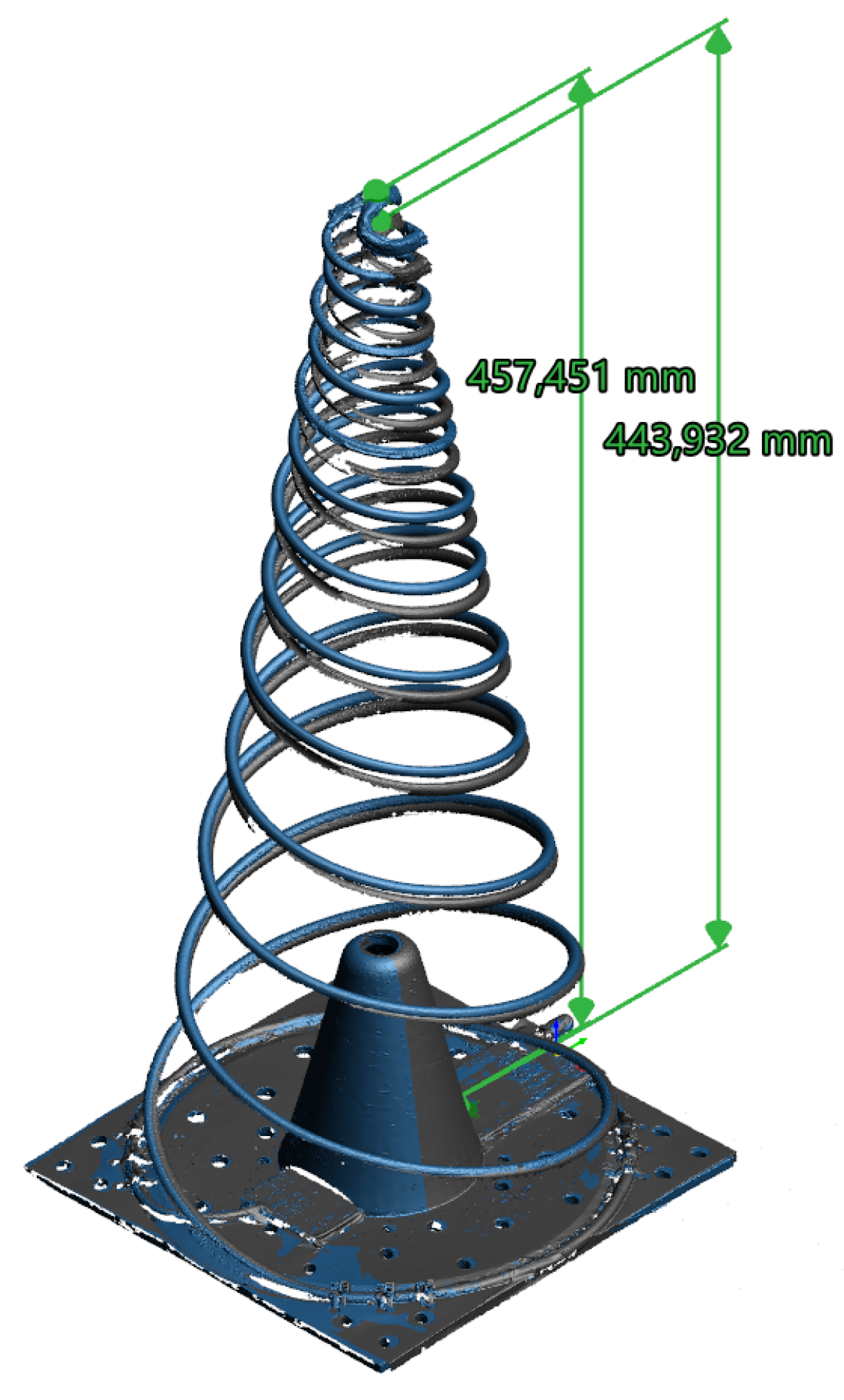


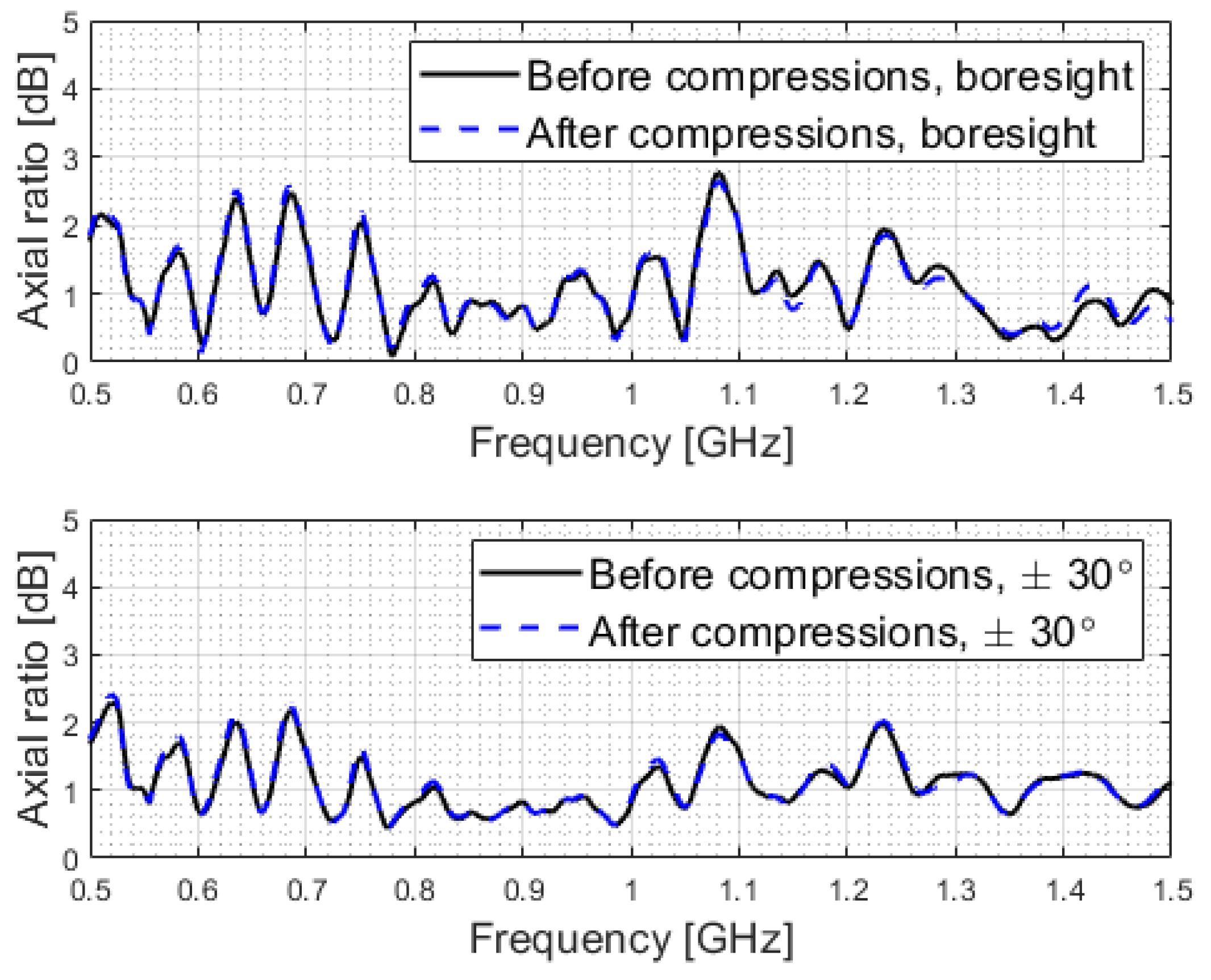
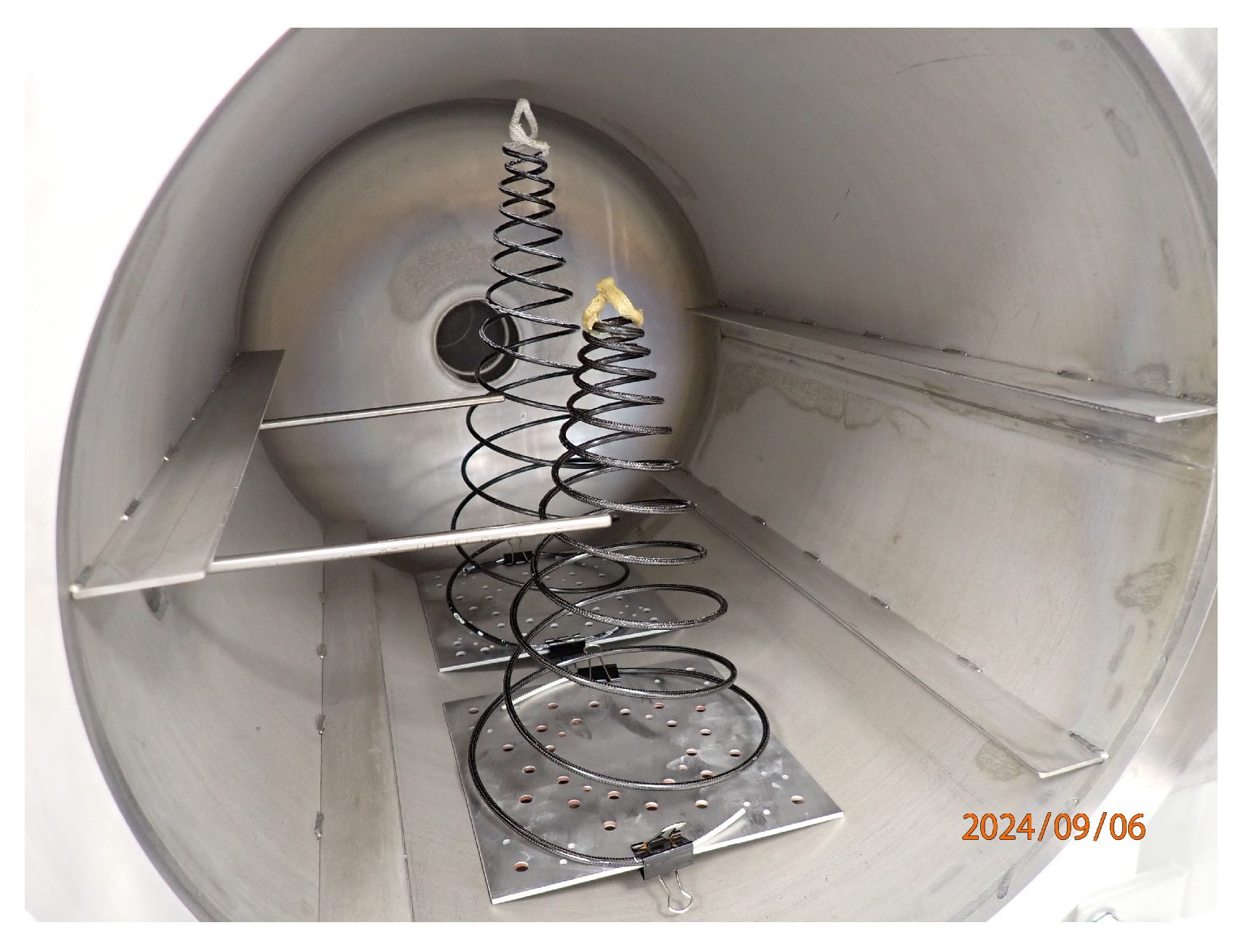
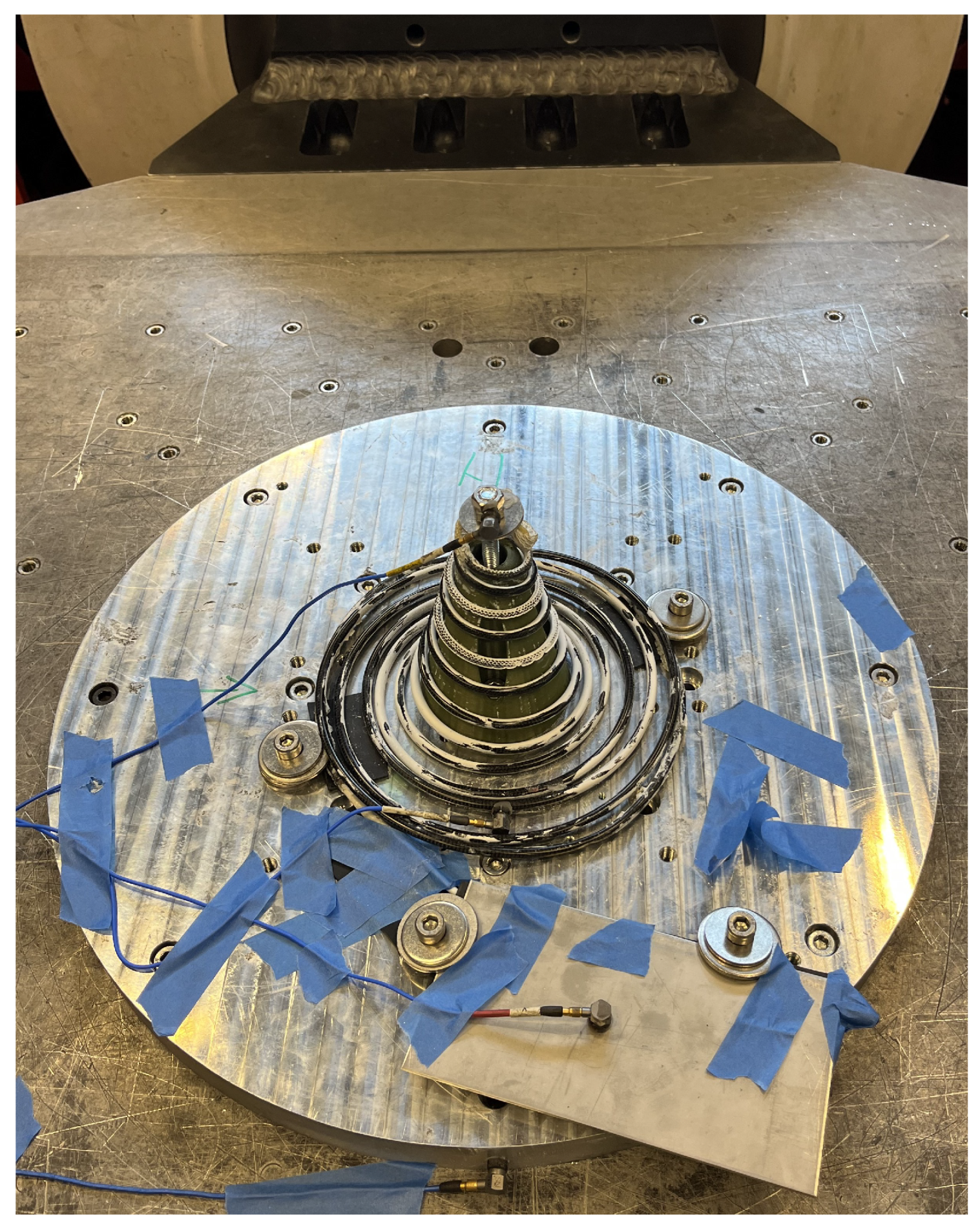
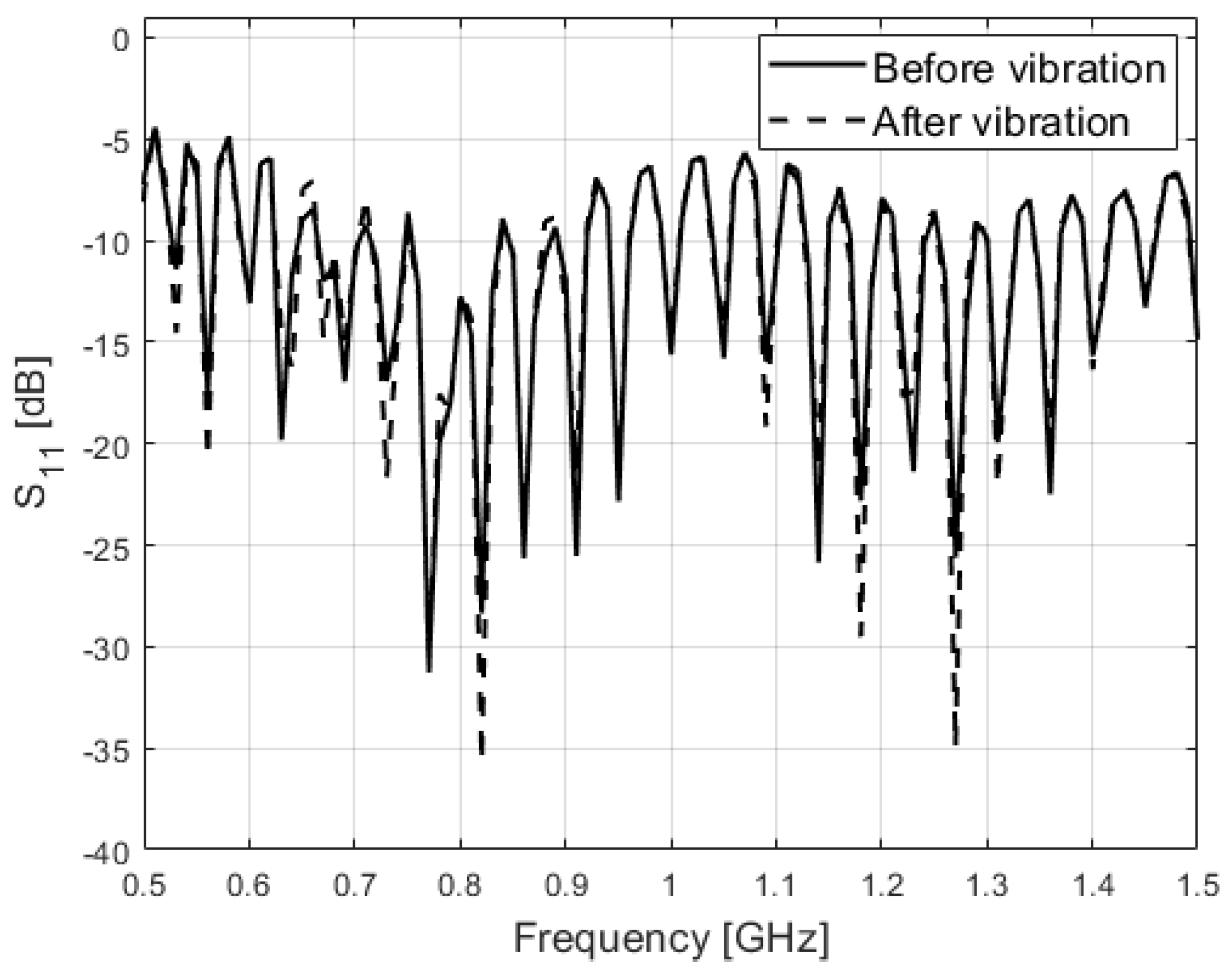
| Property | Value | Unit |
|---|---|---|
| Mass | 138 | g |
| Volume | 70,644 | mm3 |
| Surface area | 56,604 | mm2 |
| Center of mass | [0, 0, −226.2] | mm |
| = 2,416,457 = −13,974 = −277 | ||
| Moments of inertia a | = −13,974 = 2,428,015 = −70 | g*mm2 |
| = −277 = −70 = 434,208 |
| Frequency [Hz] | 5.5 | 11 | 16 | 22 | 25.25 | 31.25 | 38.25 |
| Mode axis | Z | XY | Z | XY | XY | XY | XY |
| Initial Mass | Mass After Outgassing | Percentage Loss | |
|---|---|---|---|
| First cycle | 138.777 g | 138.278 g | 0.36% |
| Second cycle | 138.278 g | 138.241 g | 0.03% |
| Test | Frequency | Level | Sweep Rate |
|---|---|---|---|
| LLSS | 0–2000 Hz | 0.5 g | 2 oct/min |
| Sine | 5 Hz | 1.875 g | 4 oct/min |
| 100 Hz | 1.875 g | 4 oct/min | |
| LLSS | 0–2000 Hz | 0.5 g | 2 oct/min |
| Random | 20 Hz | 0.02 g2/Hz | |
| 50 Hz | 0.03 g2/Hz | ||
| 700 Hz | 0.03 g2/Hz | ||
| 800 Hz | 0.06 g2/Hz | ||
| 925 Hz | 0.06 g2/Hz | ||
| 2000 Hz | 0.01288 g2/Hz | ||
| GRMS = 7.87 g | 1 min | ||
| LLSS | 0–2000 Hz | 0.5 g | 2 oct/min |
| Axis and Test | Main Mode | Amplitude | Q Factor |
|---|---|---|---|
| X, first LLSS | 460 Hz | 1.37 g | 2.8 |
| X, final LLSS | 478 Hz | 1.78 g | 4 |
| % shift | 3.91% | 29.93% | |
| Y, first LLSS | 388 Hz | 2.17 g | 5.9 |
| Y, final LLSS | 390 Hz | 2.18 g | 5.9 |
| % shift | 0.51% | 0.46% | |
| Z, first LLSS | 255 Hz | 6.47 g | 8.9 |
| Z, final LLSS | 251 Hz | 4.36 g | 6.6 |
| % shift | 1.57% | 32.61% |
Disclaimer/Publisher’s Note: The statements, opinions and data contained in all publications are solely those of the individual author(s) and contributor(s) and not of MDPI and/or the editor(s). MDPI and/or the editor(s) disclaim responsibility for any injury to people or property resulting from any ideas, methods, instructions or products referred to in the content. |
© 2025 by the authors. Licensee MDPI, Basel, Switzerland. This article is an open access article distributed under the terms and conditions of the Creative Commons Attribution (CC BY) license (https://creativecommons.org/licenses/by/4.0/).
Share and Cite
Williams, L.R.; Hjermann, N.; Sagsveen, B.; Romeijer, A.; Hoel, K.V.; Bråten, L.E. A Deployable Conical Log Spiral Antenna for Small Spacecraft: Mechanical Design and Test. Aerospace 2025, 12, 326. https://doi.org/10.3390/aerospace12040326
Williams LR, Hjermann N, Sagsveen B, Romeijer A, Hoel KV, Bråten LE. A Deployable Conical Log Spiral Antenna for Small Spacecraft: Mechanical Design and Test. Aerospace. 2025; 12(4):326. https://doi.org/10.3390/aerospace12040326
Chicago/Turabian StyleWilliams, Lewis R., Natanael Hjermann, Bendik Sagsveen, Arthur Romeijer, Karina Vieira Hoel, and Lars Erling Bråten. 2025. "A Deployable Conical Log Spiral Antenna for Small Spacecraft: Mechanical Design and Test" Aerospace 12, no. 4: 326. https://doi.org/10.3390/aerospace12040326
APA StyleWilliams, L. R., Hjermann, N., Sagsveen, B., Romeijer, A., Hoel, K. V., & Bråten, L. E. (2025). A Deployable Conical Log Spiral Antenna for Small Spacecraft: Mechanical Design and Test. Aerospace, 12(4), 326. https://doi.org/10.3390/aerospace12040326









